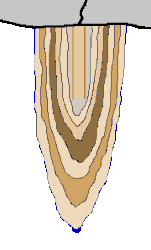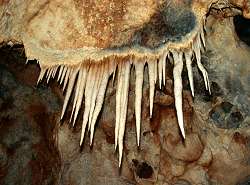Stalactite
Stalactites are dripstones pointing vertically downwards from the cave ceiling.


Stalactites are deposited by driping water. The drop is formed at the ceiling by water coming down a crack, held against gravity by the surface tension of the water. When the water drop grows, there is a point where the weight of the water gets too large for the surface tension and the drop falls down. But in the time between two drops, a small amount of carbon dioxide (CO2) goes from the water into the cave air. Without this CO2 the water is not able to keep all its limestone dissolved, its oversaturated, and a tiny amount of limestone precipitates at the ceiling.
It first forms a ring around the drop, then a tube, and so a
 soda straw
forms and gets longer and longer.
soda straw
forms and gets longer and longer.
Normally, after some time, a little dirt or calcite fills the soda straw and forces the water to flow on its outside. It’s also a matter of speed, if there is too little water and the drops are too slow, the calcite forms crystals inside the tube. This is the moment when the soda straw becomes a stalactite.
The diameter and shape of the stalactite depend on the amount of deposited limestone and the amount of water. If there is very little water, it will flow rather slow and most of the limestone is deposited near the ceiling. This results in thick stalactites. If there is much water, the limestone deposition takes place all over the stalactite, and it will be rather thin and long.
Stalactites are always thinner than other drip stones, especially stalagmites, and have a pointy lower end.
 Search DuckDuckGo for "Stalactite"
Search DuckDuckGo for "Stalactite" Stalactite - Wikipedia (visited: 07-OCT-2022)
Stalactite - Wikipedia (visited: 07-OCT-2022) Stalactite, Science Fair Projects Encyclopedia.
Stalactite, Science Fair Projects Encyclopedia.
 Index
Index Topics
Topics Hierarchical
Hierarchical Countries
Countries Maps
Maps